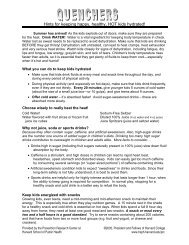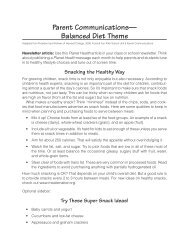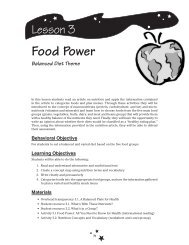<strong>Lesson</strong> <strong>19</strong> • <strong>Passing</strong> <strong>the</strong> <strong>Sugar</strong>• As you read activity <strong>19</strong>.2, <strong>Sugar</strong>y Sport Drinks?, you will learn how sugary drinkssuch as sport drinks, sodas, and fruit punches affect your body chemistry andcan increase your risk of developing type 2 diabetes.8. Direct students to read and complete <strong>the</strong> questions in activity <strong>19</strong>.2, <strong>Sugar</strong>y SportDrinks? This can be finished for homework. To improve comprehension, have studentslocate <strong>the</strong> names of <strong>the</strong> digestive organs mentioned in <strong>the</strong> reading on a diagram in<strong>the</strong> classroom or <strong>the</strong>ir textbook. Arrange <strong>the</strong> class in small groups to discuss <strong>the</strong>iranswers to <strong>the</strong> questions in activity <strong>19</strong>.2. Review <strong>the</strong> main points as a group. Remind<strong>the</strong> class of <strong>the</strong> following:• <strong>Sugar</strong> is a carbohydrate, and some sugar is found naturally in foods. We need toeat carbohydrate because it provides us with energy to move and grow. However,it’s important to choose foods such as milk, yogurt, fruits, vegetables, wholegrains breads, vitamins, minerals, and o<strong>the</strong>r nutrients we need. <strong>Sugar</strong>-sweetenedbeverages have only sugar, and this only adds “empty calories.” Making healthychoices means choosing drinks and foods without added sugar.• Drinking and eating foods with lots of added sugar increases your risk for becomingoverweight, developing dental cavities, and developing diabetes. (Review healthydrink options discussed in <strong>the</strong> Teacher Resources under Specific BackgroundMaterials.)• It’s best to avoid diet soft drinks. They contain artificial sweeteners such as Nutra-Sweet, Splenda, and sucralose, that condition you to expect “sweetness” in drinksand foods. Also, <strong>the</strong>ir long-term safety is not fully understood.Expand and Evaluate9. Allow students to clarify <strong>the</strong>ir understanding and show you what <strong>the</strong>y have learnedby using one or more of <strong>the</strong> following activities:• Pass <strong>the</strong> sugar. Assign students <strong>the</strong> following roles and distribute student resource<strong>19</strong>.1, Organ and Cell Name Tags included in <strong>the</strong> lesson. Instruct students to actout <strong>the</strong> movement of sugar from <strong>the</strong> mouth to various cells in <strong>the</strong> body. Assigna student “director” to help <strong>the</strong>m work toge<strong>the</strong>r to pass sugar molecules (tennisballs) through <strong>the</strong> correct sequence of organs and cells.RolesMouth Esophagus Stomach Small intestine HeartBlood Muscle cell Brain cell Liver cell DirectorStudents need to understand <strong>the</strong> roles of <strong>the</strong>se organs before <strong>the</strong>y can do <strong>the</strong> activity.Consider preparing <strong>the</strong>m for <strong>the</strong> role play by assigning one organ to a groupof students (give each group a label), have <strong>the</strong>m look up <strong>the</strong> functions, and <strong>the</strong>nhave groups cooperatively piece toge<strong>the</strong>r a flow chart on poster board using <strong>the</strong>irlabels. This shouldn’t take <strong>the</strong> place of <strong>the</strong> role play. Some students learn throughmovement.• Do <strong>the</strong> wave. Divide <strong>the</strong> class into two groups. Direct <strong>the</strong>m to sit in two parallel linesfacing each o<strong>the</strong>r. Tell line 1 to “do <strong>the</strong> wave” (i.e., alternate standing up and sittingdown). After a very slight delay, instruct line 2 to do <strong>the</strong> wave. Repeat this severaltimes. Tell students that <strong>the</strong>y just demonstrated what happens to blood glucoseand blood insulin after we consume refined starchy food (such as white bread).Ask <strong>the</strong>m if <strong>the</strong>y know which line represents blood glucose? Which line representsblood insulin? Ask <strong>the</strong>m to explain what’s happening (see activity <strong>19</strong>.2).• Demonstrate insulin’s role in <strong>the</strong> body. Assign four students to play <strong>the</strong> role ofsugar molecules. Assign one student to play an insulin molecule. Explain that <strong>the</strong>246
<strong>Lesson</strong> <strong>19</strong> • <strong>Passing</strong> <strong>the</strong> <strong>Sugar</strong>classroom represents a cell. The hallway is a blood capillary, or small blood vessel.Instruct <strong>the</strong> sugar molecule students to go out into <strong>the</strong> hallway (“blood”), shut <strong>the</strong>door, and demonstrate how insulin increases <strong>the</strong> permeability of <strong>the</strong> cell to sugar.(The insulin student will open <strong>the</strong> door, allowing <strong>the</strong> sugar molecules to come in.)• Acting out verbs. Select a group of six to eight students to act out <strong>the</strong> following:a. Digestion of a starch molecule into sugar molecules. You may need to give<strong>the</strong>m a reminder (starch molecules are long chains of sugar molecules) and atip (each student should represent one sugar molecule).b. Dissolving sugar into water. Divide <strong>the</strong> class in half. Instruct students to standon opposite sides of <strong>the</strong> room. Assign students on one side to be sugar molecules(solute) and those on <strong>the</strong> o<strong>the</strong>r side to be water molecules (solvent). Todemonstrate <strong>the</strong> intermolecular bonds that exist within each substance, havestudents place <strong>the</strong>ir hands on neighboring students’ shoulders. On your command,have <strong>the</strong> sugar “dissolve” into <strong>the</strong> water and form a solution. Studentswill need to break <strong>the</strong>ir links with neighbors and form new bonds with studentsfrom <strong>the</strong> o<strong>the</strong>r group. You may choose to talk about <strong>the</strong> energy needed to breakbonds and how increases in temperature can speed up this reaction.Extension Activities1. Instruct students to make a poster, advertisement, or public service announcementthat encourages kids to choose water, milk, or 100 percent juice over soda and sportdrinks.2. Have students work toge<strong>the</strong>r to develop and teach a short lesson that encouragesyounger kids to choose healthy drinks.3. Have students use model kits to build <strong>the</strong> chemical structures of simple sugars anddemonstrate how linking sugars toge<strong>the</strong>r to form chains forms complex carbohydrate.(This is appropriate for eighth-graders who have been introduced to organicchemistry.)Schoolwide Promotion or FundraiserTeach this lesson as a precursor to one of <strong>the</strong> following schoolwide promotions:• Soda Tax Fundraiser. Raise funds for your school and awareness of soda consumptionand its connection to health problems. Families are asked to keep track of <strong>the</strong>number of sodas and o<strong>the</strong>r sugary drinks <strong>the</strong>y consume in a week and to donate10 cents for each one <strong>the</strong>y drink. They can get a “tax credit” of 5 cents for eachbottle of water <strong>the</strong>y drink. Include information on <strong>the</strong> importance of limiting sugarsweetenedbeverage consumption (see <strong>the</strong> Carbohydrate Parent Sheet on <strong>the</strong> CD-ROMthat accompanies this book) and healthy beverage alternatives (see <strong>the</strong> QuenchersParent Resource on <strong>the</strong> CD-ROM) with a description of <strong>the</strong> promotion.• <strong>Health</strong>y Beverage Options: Parent Night Promotion. Offer parents samples and recipesof healthy beverage options. Possibilities could include seltzer and fruit slices, ora seltzer and fruit juice spritzer. Hand out information on <strong>the</strong> importance of limitingsugar-sweetened beverage consumption (see <strong>the</strong> Carbohydrate Parent Sheet on <strong>the</strong>CD-ROM) and healthy beverage alternatives (see <strong>the</strong> Quenchers Parent Resource on<strong>the</strong> CD-ROM).247





